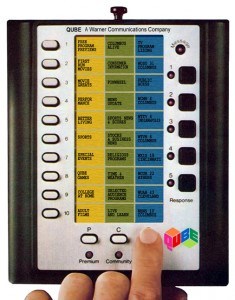Happy Thanksgiving to all Stop the Cap! readers.
While we take a break from our usual reports, let’s turn the clock all the way back to 1978, an era before broadband (or dial-up for the most part) and even before most of the basic cable networks know today existed. Cable television was not even an option yet in many communities, although discussions about the concept were well underway.
In Columbus, Ohio Warner Cable constructed an experimental two-way cable system called QUBE, which brought 30,000 homes in the city access to interactive, locally-produced programming. Viewers could vote on different topics, share their opinions, answer quizzes, and order individual pay-per-view movies — a new concept for most people back then.
Cable television in 1978 didn’t deliver CNN, TNT, ESPN, or any of dozens of other cable networks that are household names today. Instead, most delivered clear signals of broadcast television stations received over the air from a master antenna mounted high above the local cable company, supplemented with text-based information channels running newswires, sports scores, financial tickers, weather and other wire service reports. Locally produced government, public access and educational programming covered much of the rest of the channel lineup. Cable radio hooked up to home stereos and delivered improved FM radio reception and some privately run cable radio stations.
QUBE was no different in this respect. The bulk of the programming people watched came from local broadcasters and imported stations from Indianapolis, Cleveland, Cincinnati, and Athens — all selected from a wired remote control. It total, QUBE carried 30 channels, 10 of which were premium or pay per view. The concept was so revolutionary, some folks traveled from miles around to record sample programming off the system and share copies of videotapes with other cable enthusiasts.
QUBE was not a financial success for Warner, however. The costs to produce interactive programming, building brand new cable systems, and purchasing the equipment to run them, caused Warner to accumulate $875 million in total debt by 1983. It abandoned the concept a few years later because new cable networks and superstations were rapidly signing on, creating a huge number of new viewing options that effectively drowned out the locally-produced interactive shows. Cable would remain a one-way medium, at least for awhile.
Watching the enthusiasm of Ray Glasser, who produced the video included below, all over a 30-channel cable system was fascinating, as was watching the assortment of television stations sampled from more than 30 years ago. And check out those supermarket prices listed on one of the text channels Ray previews. After a series of sales and ownership transfers, Warner Cable still exists in Columbus. But today, we know it better as Time Warner Cable.
[flv width=”422″ height=”327″]http://www.phillipdampier.com/video/Qube.flv[/flv]
A video tour of Warner Cable’s QUBE system in Columbus, Ohio, produced in 1978 by Ray Glasser. (50 minutes)


 Subscribe
Subscribe
